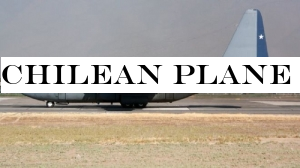INSUBCONTINENT EXCLUSIVE:
A military plane with 38 people on board has disappeared en route to Antarctica, Chile's air force says.The C-130 Hercules transport
aircraft took off from Punta Arenas at 16:55 local time (19:55 GMT), and operators lost contact soon after 18:00 (21:00).Those missing
include 17 crew and 21 passengers.They were travelling to provide logistical support to a military base on Antarctica's King George Island
A search-and-rescue mission is under way.Air Force General Eduardo Mosqueira told local media that the plane did not activate any distress
signal.He said the plane, whose pilot had extensive experience, may have been forced to land after running out of fuel.An air force
statement that the plane was about 450 miles into its 770-mile journey when contact was lost, placing it within the Drake Passage.The Drake
Passage is body of water connecting the South Atlantic and South Pacific Oceans, and is known for treacherous weather conditions
But Chile's air force said local weather was good at the time of the plane's disappearance.President Sebastián Piñera said in a tweet
that he was "dismayed" by the loss, and was monitoring the situation from the capital, Santiago.Chile controls over 1.2 million sq km
(463,000 sq miles) of Antarctic territory, bordering land claimed by the UK and Argentina
Within this territory it operates nine bases - the most of any country in the world.
How likely are you to survive a plane crash?
The
plane that crashed in Mexico's Durango state reportedly lost both of its engines News that all 103 passengers survived a plane crash in
Mexico's Durango state on Tuesday may seem incredible, especially given the dramatic pictures of the smoking wreckage.Almost all those on
board were injured in the accident, but most reportedly walked away from the wreckage with only light injuries.
How unusual is this? Well,
surprisingly, it may not be as rare as you'd think.What are our odds of surviving an accident?Put simply, there is no clear-cut answer -
just as we can't definitively say how survivable car accidents are, because it depends entirely on the circumstances.But when the US
National Transportation Safety Board did a review of national aviation accidents from 1983-1999, it found that more than 95% of aircraft
occupants survived accidents, including 55% in the most serious incidents.Our chances largely depend on factors like the presence of fire,
the altitude a mishap takes place at, and its location.The European Transport Safety Council estimated that 90% of aircraft accidents were
technically survivable in a study in 1996.In 2009, 150 passengers famously survived a plane downing in New York's Hudson RiverIn the two
decades since these two studies were done, airline safety has improved even further, with fatal accidents steadily declining.
Flying is
statistically less risky than other modes of transport, but that doesn't stop some of us worrying.
It could be because we mostly see
dramatic and fatal incidents on the news, or dramatised by Hollywood.
What determines if a crash is survivable?Tom Farrier, former director
of safety at the Air Transport Association, explained on the website Quora that three general conditions help determine whether an accident
is survivable:
Whether the forces encountered by human occupants are within the limits of human toleranceWhether the structures surrounding
the plane) remain substantially intactWhether the post-crash environment presents an immediate threat to occupants or rescuersIn short: how
bad any impact was for the body, how much damage was done to the aircraft, and whether the wreckage and environment around it are safe.
In
the case of Mexico, the plane crashed shortly after take-off and most of the injured passengers were able to get away before the aircraft
caught fire.
Image copyrightGETTY IMAGESImage captionIn November 2016, 71 people died on a flight chartered for Brazilian football team
Only six survived - including Jakson Follmann (pictured)Asked if it was worse to crash on land or sea, aviation consultant Adrian Gjertsen
says it has more to do with the proximity of rescue services than the surface.
"For instance, during the incident on the Hudson River,
there were rescue services readily available
But if you're in the middle of an ocean there's going to be more of a problem because of simply getting back to dry land," he told the
BBC.
"If there was an accident in the Sahara or the middle of the Atlantic - I wouldn't say there's an enormous difference between them
really, insomuch as there's no one there to help."
How can we boost our odds?The internet is full of advice on this topic: wearing your
seatbelt, not wearing flammable clothes, and counting the seat rows in advance in case the lights fail.
People also debate where in an
aircraft it's safest to sit, and some research suggests crash records show the rear could be marginally safer.
Mr Gjertsen says it is not
that simple, and that it all depends on the aircraft and the individual incident.
Media captionAir Steward: "No one pays attention to the
in-flight demonstration"."One of the issues that has caused problems is passengers' desire to collect their baggage and depart with it," he
says.
"That will prejudice safety - not only of themselves, but everyone else as well.
"It's inevitably human nature that you want to,
but if something does go wrong you need to get away from the situation."
See more stories and videos like this
In general, experts say
being aware of your surroundings and being quick to exit is key, as is listening to the rest of the safety advice offered.
"All I can
really stress is how safe aviation in general is," Mr Gjertsen says.
"And the idea is to prevent something that you need to survive from
happening in the first place."

